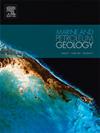Seismic geomorphology of the karstified Upper Jurassic-Lower Cretaceous carbonate succession in the Carpathian Foredeep area, Poland
IF 3.6
2区 地球科学
Q1 GEOSCIENCES, MULTIDISCIPLINARY
引用次数: 0
Abstract
Characterization of subsurface reservoirs composed of soluble rock formations is commonly challenged by the presence of structures forming irregularly distributed, multi-scale inhomogeneities originating from karstification and karst degradation. Although the majority of paleokarst features occur at sub-seismic scales, seismic data interpretation can provide information on type and spatial distribution of meso-scale karst features. Integrating these with other data sources and a genetic understanding of karst formation provides a means to decipher former karst systems and their extent and potential impact on subsurface reservoirs. In turn this offers the potential for improved reservoir characterization and reducing exploration- and production-risks. The present work investigates the Upper Jurassic–Lower Cretaceous carbonate succession located in the Polish sector of the Carpathian Foredeep. From the Early Cretaceous to Middle Miocene, the stratigraphic record reveals that the region experienced two prolonged episodes of subaerial exposure, highlighting the potential for extensive overprinting of these formations by karst during these events. Using conventional 3D seismic data, supplemented by wireline logs, numerous karst-related features can be identified and mapped. Detailed structural, stratigraphic, and geomorphological analysis suggest that karst development was controlled by lithological and tectonic factors, as well as relative sea level change. The results are synthesized into a conceptual model for regional karst evolution and its impact on the Upper Jurassic–Lower Cretaceous carbonate succession in the Carpathian Foredeep. Our study demonstrates the utility of applying an integrated workflow when characterizing paleokarst systems in geologically complex, carbonate successions.
波兰喀尔巴阡前深地区上侏罗统—下白垩统岩溶碳酸盐岩序列的地震地貌
由可溶性岩层组成的地下储层的表征通常受到由岩溶作用和岩溶退化形成的不规则分布、多尺度不均匀结构的挑战。虽然大多数古岩溶特征发生在亚地震尺度,但地震资料解释可以提供中尺度岩溶特征的类型和空间分布信息。将这些数据与其他数据来源以及对喀斯特构造的成因理解相结合,可以提供一种破译前喀斯特系统及其范围和对地下储层的潜在影响的方法。反过来,这也为改善储层特征、降低勘探和生产风险提供了潜力。本文研究了位于喀尔巴阡前深波兰段的上侏罗世-下白垩世碳酸盐岩演替。从早白垩世到中中新世,地层记录显示该地区经历了两次长时间的地面暴露,突出了这些事件中喀斯特对这些地层的广泛覆盖的可能性。利用常规的三维地震数据,辅以电缆测井,可以识别和绘制许多与岩溶有关的特征。详细的构造、地层和地貌分析表明,喀斯特发育受岩性和构造因素以及相对海平面变化的控制。综合研究结果,建立了喀尔巴阡前深区域岩溶演化及其对上侏罗统—下白垩统碳酸盐岩演替影响的概念模型。我们的研究表明,在地质复杂的碳酸盐层序中,应用综合工作流程描述古岩溶系统是有用的。
本文章由计算机程序翻译,如有差异,请以英文原文为准。
求助全文
约1分钟内获得全文
求助全文
来源期刊

Marine and Petroleum Geology
地学-地球科学综合
CiteScore
8.80
自引率
14.30%
发文量
475
审稿时长
63 days
期刊介绍:
Marine and Petroleum Geology is the pre-eminent international forum for the exchange of multidisciplinary concepts, interpretations and techniques for all concerned with marine and petroleum geology in industry, government and academia. Rapid bimonthly publication allows early communications of papers or short communications to the geoscience community.
Marine and Petroleum Geology is essential reading for geologists, geophysicists and explorationists in industry, government and academia working in the following areas: marine geology; basin analysis and evaluation; organic geochemistry; reserve/resource estimation; seismic stratigraphy; thermal models of basic evolution; sedimentary geology; continental margins; geophysical interpretation; structural geology/tectonics; formation evaluation techniques; well logging.
 求助内容:
求助内容: 应助结果提醒方式:
应助结果提醒方式:


